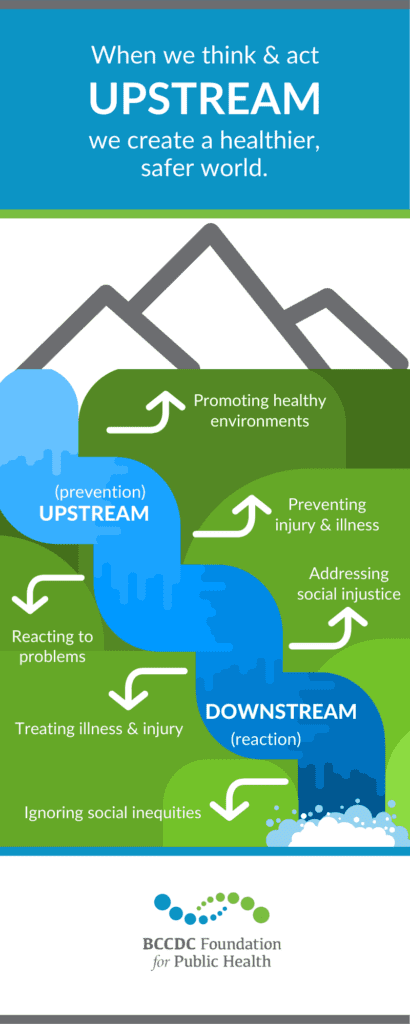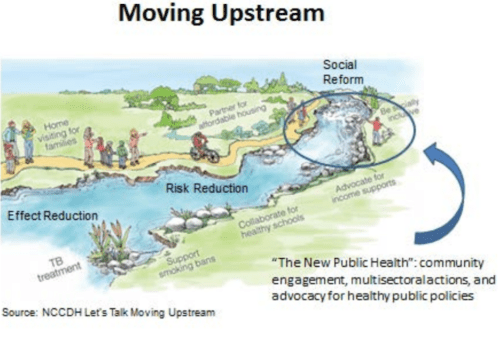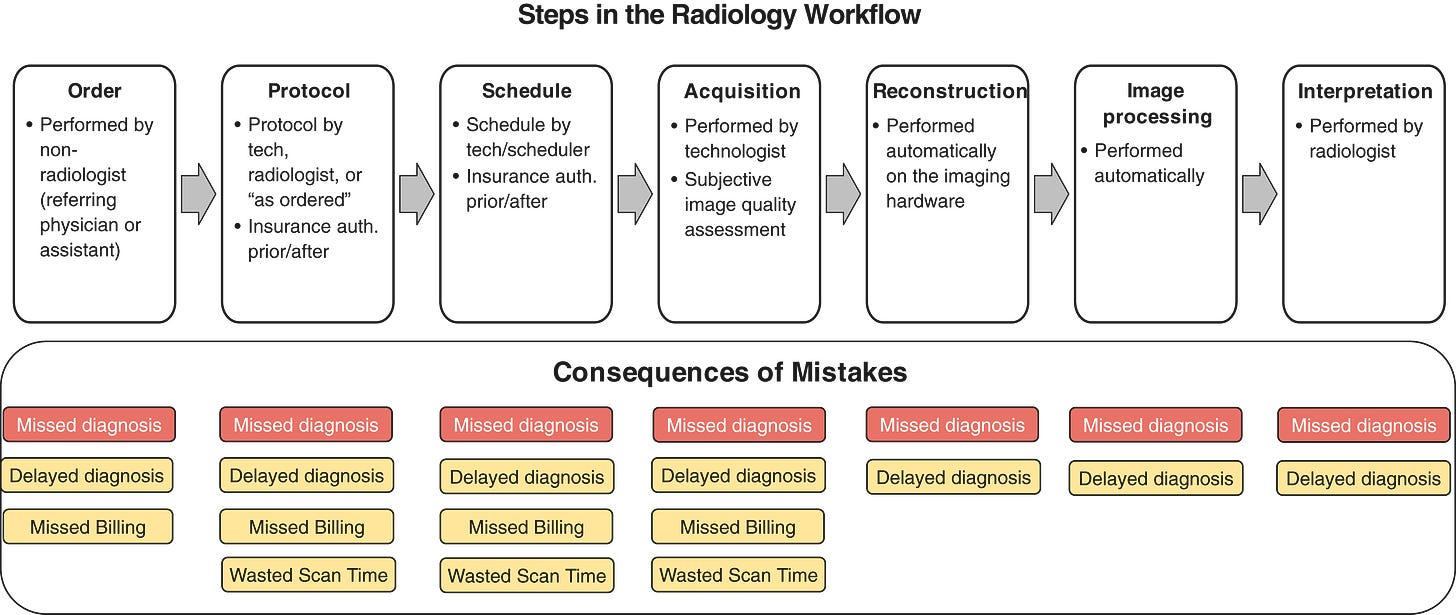In the last few weeks I’ve encountered the idea of moving things ‘upstream’ on five separate occasions.
I probably first encountered the term ‘upstream’ in the 1990’s as it related to Deming’s ideas about quality control, where organisations that wanted to improve quality were encouraged to build quality in upstream processes, e.g. in the early stages of development of the product or service, rather than in the final downstream stages of process.
The idea made quite an impact on me and has certainly had an influence on my subsequent thinking and practice.
However, I thought it might be interesting to find out who first came up with metaphor of ‘upstream’ thinking.
It turns out that physician John McKinlay in an address to the American Heart Association in 1974, described his frustration with medical practice by using the analogy of a rapidly flowing river to represent illness.
He suggested that physicians are typically so caught up in constantly rescuing ‘victims’ from this river that they have no time to look upstream to see who is pushing their patients into the water.
He further suggested that too many people in healthcare were engaged in “downstream endeavours,” which he characterised as short-term, problem-specific, individual-based interventions.
As a result, he said that they should refocus and look upstream, where the real problems mostly lie and learn lessons for how to intervene from that vantage point.
This idea of moving upstream links to the concept of wise decision making.
If upstream thinking is about seeing the bigger picture and taking a longer term view then the parallels become incredibly strong.
But before examining this idea in more depth I thought it might be worthwhile looking at a few examples of how ‘upstream thinking’ is being demonstrated in a number of disparate fields.
UPSTREAM THINKING - ELECTRIC VEHICLE AND BATTERY PRODUCTION
China has positioned itself as a global leader in the rapidly growing EV and lithium-ion battery markets, anticipating a value of $1.3 trillion by 2028.
China has focused on controlling a significant portion of the upstream activities. This includes the sourcing of critical minerals like lithium, nickel, cobalt, and graphite, and extending to the manufacturing of lithium-ion batteries. This upstream control not only ensures supply chain security but also places China in a compelling, influential position across the global market.
Through these strategic moves, China has effectively ensured its long-term stake and leadership in the future of transportation and energy, clearly illustrating its upstream thinking in navigating the evolving dynamics of the global automotive market.
UPSTREAM THINKING - TECHNOLOGY
Apple is known for its innovative approach to upstream marketing. A significant part of their strategy involves investing heavily in research and development to create groundbreaking products that define new categories or set higher standards within existing ones. For example, before the launch of the original iPhone in 2007, Apple identified a growing consumer demand for a seamless integration of phone, internet, and music into a single device.
Through years of market research and technological development, they were able to introduce a product that revolutionised not just the smartphone market, but also consumer expectations of technology.
This upstream approach allowed Apple to create a demand for a product consumers didn't even know they needed, essentially building a new market and establishing long-term brand loyalty.
UPSTREAM THINKING - OIL AND GAS
Another example of upstream thinking in the energy sector comes from Ørsted, a Danish multinational power company previously known as DONG Energy (Danish Oil and Natural Gas). Ørsted's transformation from one of the most coal-intensive energy companies in Europe to a global leader in offshore wind power is a pioneering case of upstream thinking in response to the urgent need for sustainable energy solutions.
In the mid-2000s, Ørsted made a strategic decision to shift focus from fossil fuels to renewable energy, driven by the recognition of climate change's impact and the potential of renewables. This decision marked the beginning of its transformation.
Ørsted invested heavily in offshore wind technology and projects, pioneering many of the world’s largest wind farms. The company divested its upstream oil and gas assets to fund its expansion into wind power, becoming a global leader in this segment.
Ørsted committed to an ambitious goal of completely phasing out coal from its operations by 2023 and aims to be carbon neutral in energy generation and operations by 2025. It plans for a complete transition to renewable energy by 2040, setting a benchmark for the global energy industry.
UPSTREAM THINKING - YOUTH WORK
The "HeadStart" programme, funded by The National Lottery Community Fund in the United Kingdom, aimed to improve the mental well-being of young people aged 10-16 by equipping them with the skills to cope better with challenges.
HeadStart's approach to early intervention and prevention in mental health has seen promising results in various communities across the UK.
It prevented approximately 800 students from experiencing a school exclusion in 2016/17, its first year of implementation. This represented a 10% reduction in exclusion rates across HeadStart local areas. Based on the estimated effects of HeadStart on pupils' exclusion rates that are statistically significant, the programme saved around £6 million by reducing exclusions in 2016/17.
Research shows that investing in youth work leads to significant improvements in mental health and wellbeing, reduces youth offending, and boosts educational attainment and equity– making significant cost savings to the public purse.
However, pressure on immediate budgets is forcing such projects to be abandoned leaving everyone ot focus on ‘downstream’ activities which don’t tackle the fundamental upstream issues which are causing ‘bodies’ to fall into the water in the first place.
UPSTREAM THINKING - RADIOLOGY
Upstream thinking in Radiology links to the application of artificial intelligence (AI)
By identifying and addressing inefficiencies before they affect patient care, AI can optimise healthcare delivery and patient outcomes
Paul Chang, MD, of the University of Chicago said radiologists must be
"intimately involved in guiding the rapid yet careful application of AI for image interpretation in support of access to high-quality affordable diagnostic services for the diverse range of patients in need of radiologists' care," .
Chang said that when talking about the role that AI will play in radiology, its benefit in detection and diagnosis may be overemphasized.
"That is not necessarily where the benefit of AI is going to be," he said. "The real benefit is going to be on upstream workflow optimisation."
For example, the use of AI should help shorten the time it takes to acquire an MRI. Or, instead of making a patient come back for additional imaging because of an incorrect technical acquisition, AI could notify a technologist before a patient finishes the exam and leaves the office.
WISE DECISION MAKING AND UPSTREAM THINKING
Wise decision making requires the leader to make sense of complexity. Too often the simplistic approach is to look for a solution that addresses the problem, e.g. we have people dying of lung cancer, therefore we need to improve our treatment of the illness.
Making sense if this complexity encourages leaders to look more specifically at the causes of cancer and see those relationships as being of critical importance.
By thinking upstream, such as, increasing the price of cigarettes, banning smoking from public places, removing adverts from sport and television, and gradually making it illegal for people if a certain ages to purchase tobacco products all combine to dramatically lower the incidence of lung cancer.
Wise leaders are constantly thinking about how their actions and decisions can have a sustainable impact beyond the here and now. In that manner they are always looking upstream.
Obviously, there are circumstances where a leader needs to deal with downstream issues, such as emergencies or operational issues which undermine the very existence of the organisation.
However, when such behaviour becomes the dominant perspective, where people are only focused on the immediacy of our actions in terms of cause and effect, e.g. we have a problem, I solve it it, I feel better about my efficacy.
Thinking upstream doesn’t provide the same immediate psychological return, as results can take a long time to become obvious.
That’s why upstream thinking requires leaders to make courageous and ethical decisions formed out of a sense of obligation to a sustainable future and the common good, as opposed to a personal checklist of achievements.
This is why upstream thinking can be problematic for populist leaders who look for immediate results while ignoring the long-term negative consequences of their actions.
In conclusion, wise leaders make sense of upstream and downstream actions, but, where circumstances allow, will always shift their focus upstream to stop the bodies falling into the water in the first place!








